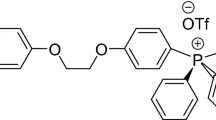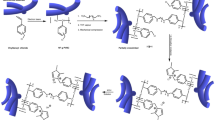Abstract
Anion exchange membrane (AEM) water electrolyser provides a promising alternative to proton exchange membrane water electrolysis due to the relative cheap of AEM and no-need of expensive platinum group catalysts. However, the development of AEM water electrolyser is hampered by the low alkaline and dimensional stability of AEMs, especially in highly concentrated alkaline solution and at elevated temperatures. Recently we synthesized a poly(triphenyl N-methylquinuclidinium) AEM with excellent alkaline stability. To further improve the mechanical strength and dimensional stability of this kind of AEM, in this work, we added trifluoacetophenone to prepare a poly(triphenyl trifluoacetophenone N-methylquinuclidinium) membrane, which exhibits superior alkaline stability (no degradation of conductivity and mechanical strength for 1600 h in 10 mol L−1 NaOH at 80°C), excellent dimensional stability (swelling ratio: <7%, in pure water, 30–80°C; <2%, in 10 mol L−1 NaOH, 30–80°C), high OH− conductivity (134.5 mS cm−1 at 80°C) and high mechanical strength (tensile strength = 43.2 MPa). The assembled water electrolyser, comprising this AEM and nickel-alloy foam electrodes, exhibits outstanding current density (1780 mA cm−2) at 2.0 V with 5 mol L−1 KOH aqueous electrolyte at 80°C, and high durability when assembled with nickel foam electrodes.

摘要
阴离子交换膜水电解槽的阴离子交换膜成本低、无需铂族贵金属催化剂, 有望取代高成本的质子交换膜水电解槽. 然而, 阴离子交换膜的尺寸稳定性差以及在高温、高浓度碱液中的稳定性差, 阻碍了阴离子交换膜水电解槽的发展. 最近, 我们合成了一种具有优异碱性稳定性的聚(三苯基-N-甲基奎宁基)阴离子交换膜, 为了进一步提高这种阴离子交换膜的机械强度和尺寸稳定性, 在本工作中, 我们添加了三氟苯乙酮来制备聚(三苯基-三氟苯乙酮-N-甲基奎宁基)阴离子交换膜. 这种共聚阴离子交换膜具有超高的碱性稳定性(在80°C, 10 mol L−1的NaOH溶液中浸泡1600小时后OH−电导率和机械强度不发生衰减), 优异的尺寸稳定性(30–80°C温度下, 纯水中溶胀率不超过7%; 10 mol L−1的NaOH 溶液中溶胀率不超过2%), 高氢氧根电导率(80°C 时达134.5 mS cm−1)和高机械强度(抗拉伸强度达43.2 MPa). 这种阴离子交换膜和镍合金泡沫电极组装的简易水电解槽在80°C 下, 2.0 V 和5 mol L−1的KOH水电解质中具有1780 mA cm−2的优异电流密度, 并且具有高耐久性.
Similar content being viewed by others
References
Yang Y, Li P, Zheng X, et al. Anion-exchange membrane water electrolyzers and fuel cells. Chem Soc Rev, 2022, 51: 9620–9693
Du N, Roy C, Peach R, et al. Anion-exchange membrane water electrolyzers. Chem Rev, 2022, 122: 11830–11895
Kusoglu A, Weber AZ. New insights into perfluorinated sulfonic-acid ionomers. Chem Rev, 2017, 117: 987–1104
Cullen DA, Neyerlin KC, Ahluwalia RK, et al. New roads and challenges for fuel cells in heavy-duty transportation. Nat Energy, 2021, 6: 462–474
Chen N, Lee YM. Anion exchange polyelectrolytes for membranes and ionomers. Prog Polym Sci, 2021, 113: 101345
Zhang F, Zhang Y, Sun L, et al. A π-conjugated anion-exchange membrane with an ordered ion-conducting channel via the McMurray coupling reaction. Angew Chem Int Ed, 2023, 62: e202215017
Chen H, Tao R, Bang KT, et al. Anion exchange membranes for fuel cells: State-of-the-art and perspectives. Adv Energy Mater, 2022, 12: 2200934
Olsson JS, Pham TH, Jannasch P. Poly(arylene piperidinium) hydroxide ion exchange membranes: Synthesis, alkaline stability, and conductivity. Adv Funct Mater, 2018, 28: 1702758
Bai H, Peng H, Xiang Y, et al. Poly(arylene piperidine)s with phosphoric acid doping as high temperature polymer electrolyte membrane for durable, high-performance fuel cells. J Power Sources, 2019, 443: 227219
Pan D, Bakvand PM, Pham TH, et al. Improving poly(arylene piperidinium) anion exchange membranes by monomer design. J Mater Chem A, 2022, 10: 16478–16489
Chen N, Jin Y, Liu H, et al. Insight into the alkaline stability of N-heterocyclic ammonium groups for anion-exchange polyelectrolytes. Angew Chem Int Ed, 2021, 60: 19272–19280
Wu X, Chen N, Klok H, et al. Branched poly(aryl piperidinium) membranes for anion-exchange membrane fuel cells. Angew Chem Int Ed, 2022, 61: e202114892
Allushi A, Pham TH, Olsson JS, et al. Ether-free polyfluorenes tethered with quinuclidinium cations as hydroxide exchange membranes. J Mater Chem A, 2019, 7: 27164–27174
You W, Ganley JM, Ernst BG, et al. Expeditious synthesis of aromatic-free piperidinium-functionalized polyethylene as alkaline anion exchange membranes. Chem Sci, 2021, 12: 3898–3910
Zeng M, He X, Wen J, et al. N-methylquinuclidinium-based anion exchange membrane with ultrahigh alkaline stability. Adv Mater, 2023, 35: 2306675
Yang Z, Guo R, Malpass-Evans R, et al. Highly conductive anion-exchange membranes from microporous Tröger’s base polymers. Angew Chem Int Ed, 2016, 55: 11499–11502
Liu G, Wang A, Ji W, et al. In-situ crosslinked, side chain polybenzimidazole-based anion exchange membranes for alkaline direct methanol fuel cells. Chem Eng J, 2023, 454: 140046
Zhang X, Guo J, Chu X, et al. Mechanically flexible bulky imidazolium-based anion exchange membranes by grafting PEG pendants for alkaline fuel cells. J Membrane Sci, 2022, 659: 120820
Wu X, Chen N, Hu C, et al. Fluorinated poly(aryl piperidinium) membranes for anion exchange membrane fuel cells. Adv Mater, 2023, 35: 2210432
Joshi T, Chen C, Li H, et al. Local electronic structure of molecular heterojunctions in a single-layer 2D covalent organic framework. Adv Mater, 2019, 31: 1805941
Besidsky Y, Luthman K, Claesson A, et al. Synthesis and reactivity of 6-carbamoyl-5-phenyl-2,3,5,6-tetrahydro-1H-1,4-ethanobenzo[f]quinoline. X-ray molecular structure of (4aR,5S,6R,10bR)-5-phenyl-2,3,4a,5,6,10b-hexahydro-1H-1,4-ethanobenzo[f]quinolin-6-yl acetate. J Chem Soc Perkin Trans 1, 1995, 4: 475–480
Chen N, Hu C, Wang HH, et al. Poly(alkyl-terphenyl piperidinium) ionomers and membranes with an outstanding alkaline-membrane fuel-cell performance of 2.58 Wcm−2. Angew Chem Int Ed, 2021, 60: 7710–7718
Chen N, Wang HH, Kim SP, et al. Poly(fluorenyl aryl piperidinium) membranes and ionomers for anion exchange membrane fuel cells. Nat Commun, 2021, 12: 2367
Song W, Peng K, Xu W, et al. Upscaled production of an ultramicroporous anion-exchange membrane enables long-term operation in electrochemical energy devices. Nat Commun, 2023, 14: 2732
Xu G, Pan J, Zou X, et al. High-performance poly(biphenyl piperidinium) type anion exchange membranes with interconnected ion transfer channels: Cooperativity of dual cations and fluorinated side chains. Adv Funct Mater, 2023, 33: 2302364
Zou X, Xu G, Fang P, et al. Unsupervised learning-guided accelerated discovery of alkaline anion exchange membranes for fuel cells. Angew Chem Int Ed, 2023, 62: e202300388
Zhang M, Liu J, Wang Y, et al. Highly stable anion exchange membranes based on quaternized polypropylene. J Mater Chem A, 2015, 3: 12284–12296
Zhang M, Shan C, Liu L, et al. Facilitating anion transport in polyolefin-based anion exchange membranes via bulky side chains. ACS Appl Mater Interfaces, 2016, 8: 23321–23330
Liu M, Hu X, Hu B, et al. Soluble poly(aryl piperidinium) with extended aromatic segments as anion exchange membranes for alkaline fuel cells and water electrolysis. J Membrane Sci, 2022, 642: 119966
Yang K, Li X, Guo J, et al. Preparation and properties of anion exchange membranes with exceptional alkaline stable polymer backbone and cation groups. J Membrane Sci, 2020, 596: 117720
Lu C, Long C, Li Y, et al. Chemically stable poly(meta-terphenyl piperidinium) with highly conductive side chain for alkaline fuel cell membranes. J Membrane Sci, 2020, 598: 117797
Xu S, Wei W, Su X, et al. Crown-ether block copolymer based poly (isatin terphenyl) anion exchange membranes for electrochemical energy conversion devices. Chem Eng J, 2023, 455: 140776
Gao XL, Sun LX, Wu HY, et al. Highly conductive fluorine-based anion exchange membranes with robust alkaline durability. J Mater Chem A, 2020, 8: 13065–13076
Song W, Liang X, Zhang H, et al. Ultrathin anion exchange membranes with an improved OH− transfer rate for high-performance AEMFCs. J Mater Chem A, 2022, 10: 21503–21511
Jiang T, Wu C, Zhou Y, et al. Highly stable poly(p-quaterphenylene alkylene)-based anion exchange membranes. J Membrane Sci, 2022, 647: 120342
Jiang T, Wang C, Wang T, et al. Imidazolium structural isomer pyrazolium: A better alkali-stable anion conductor for anion exchange membranes. J Membrane Sci, 2022, 660: 120843
Hsu JH, Peltier CR, Treichel M, et al. Direct insertion polymerization of ionic monomers: Rapid production of anion exchange membranes. Angew Chem Int Ed, 2023, 62: e202304778
Zhang W, Liu M, Gu X, et al. Water electrolysis toward elevated temperature: Advances, challenges and frontiers. Chem Rev, 2023, 123: 7119–7192
Chung DY, Lopes PP, Farinazzo Bergamo Dias Martins P, et al. Dynamic stability of active sites in hydr(oxy)oxides for the oxygen evolution reaction. Nat Energy, 2020, 5: 222–230
Chen P, Hu X. High-efficiency anion exchange membrane water electrolysis employing non-noble metal catalysts. Adv Energy Mater, 2020, 10: 2002285
Chen N, Paek SY, Lee JY, et al. High-performance anion exchange membrane water electrolyzers with a current density of 7.68 A cm−2 and a durability of 1000 hours. Energy Environ Sci, 2021, 14: 6338–6348
Razmjooei F, Morawietz T, Taghizadeh E, et al. Increasing the performance of an anion-exchange membrane electrolyzer operating in pure water with a nickel-based microporous layer. Joule, 2021, 5: 1776–1799
Motealleh B, Liu Z, Masel RI, et al. Next-generation anion exchange membrane water electrolyzers operating for commercially relevant lifetimes. Int J Hydrogen Energy, 2021, 46: 3379–3386
Kraglund MR, Carmo M, Schiller G, et al. Ion-solvating membranes as a new approach towards high rate alkaline electrolyzers. Energy Environ Sci, 2019, 12: 3313–3318
Li H, Yu N, Gellrich F, et al. Diamine crosslinked anion exchange membranes based on poly(vinyl benzyl methylpyrrolidinium) for alkaline water electrolysis. J Membrane Sci, 2021, 633: 119418
Acknowledgements
This work was supported by the Knowledge Innovation Program of Wuhan-Basic Research (2022010801010321) and Wuhan Limo Technology Limited Company (2022420111000256 and 2023420111000277).
Author information
Authors and Affiliations
Contributions
Author contributions Li M designed the experiments; Wen J and He X performed the experiments; Li M and Wen J analyzed the data and wrote the paper. All authors contributed to the general discussion.
Corresponding author
Ethics declarations
Conflict of interest The authors declare that they have no conflict of interest.
Additional information
Supplementary information Experimental details and supporting data are available in the online version of the paper.
Ju Wen received her Bachelor’s degree in chemistry from Hubei University in 2018 and is currently pursuing her PhD degree under the supervision of Prof. Ming Li at Hubei University. Her research interests focus on ion exchange membranes and their applications in water splitting for hydrogen production.
Xianying He received his Bachelor’s degree in applied chemistry from Hubei University in 2021. Currently, he is pursuing a Master’s degree under the guidance of Prof. Ming Li. His current research interests focus on the synthesis of advanced anion exchange membranes and their applications in water electrolysis and fuel cells.
Ming Li is a professor at Hubei University. He received a Doctor degree from ETH Zurich, a Master’s degree from Tsinghua University and a Bachelor’s degree from Huazhong University of Science and technology. His research interests mainly focus on proton exchange membranes, anion exchange membranes, nanofiltration membranes, porous polymer materials and their applications in fuel cells, water splitting for hydrogen production, CO2 capture, solvent separation and so on.
Supporting Information
40843_2023_2761_MOESM1_ESM.pdf
Poly(aryl N-methyl quinuclidinium) anion exchange membrane with both ultra-high alkaline stability and dimensional stability
Rights and permissions
About this article
Cite this article
Wen, J., He, X., Zhang, G. et al. Poly(aryl N-methyl quinuclidinium) anion exchange membrane with both ultra-high alkaline stability and dimensional stability. Sci. China Mater. 67, 965–973 (2024). https://doi.org/10.1007/s40843-023-2761-9
Received:
Accepted:
Published:
Issue Date:
DOI: https://doi.org/10.1007/s40843-023-2761-9




